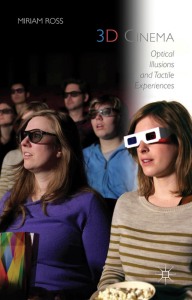I’m really pleased to say that my book on 3D Cinema was published in March 2015:
3D Cinema: Optical Illusions and Tactile Experiences
by Miriam Ross
Hardcover 240 pages ISBN 9781137378569
http://www.palgrave.com/page/detail/3d-cinema-miriam-ross/?K=9781137378569
Although much of the research for the book was undertaken before I began this blog, my posts reflect the evolution of my thoughts on 3D cinema and some of this analysis made it directly into the book. When I began researching stereoscopic cinema in 2009 it was widely expected to be a passing fad with little more duration than the previous boom and bust periods of the 1950s and 1980s. In pub conversations I made various bets about whether stereoscopic cinema would still be around a couple of years later. In the half-decade since that point there have been numerous articles decreeing the death of digital 3D and the final demise of the format. And although stereoscopic cinema may shortly exit the commercial cinema arena once again, right now 3D films account for the top 7 films in Box Office Mojo’s worldwide grosses chart. Many blockbuster films in production or lined up for production in the coming years are going to be filmed in 3D or will have stereoscopic conversions. 3D cinema’s spread is global with many emerging movie-theatre markets such as Latin America and Russia at the forefront of upgrades to 3D screening technologies. There have also been many films made outside of global Hollywood including a recent surge of films from Asia. If 3D cinema is truly dying then it is taking a long time to do so.
One of the most interesting things about researching the recent era of digital 3D cinema has been watching the polarised nature of debates on this topic. Strong statements are made in favour of or against stereoscopy. Some critics and filmmakers claim it is a gimmick and distraction that ruins the essence of cinema while others are certain that 3D will soon become the new norm on a par with colour and sound. Even those who take a more balanced approach often declare that there is a ‘correct’ way to do 3D cinema in order to avoid improper gimmicks and audience fatigue. It is this context that has produced exciting, charged discussion that asks us to consider not only 3D cinema but also the present and future of what cinema means to us. Although my book does not attempt to produce an historical narrative of 3D cinema’s development, it is concerned with articulating a longer and broader view of how stereoscopy has and continues to operate. In doing so, I hope I have been able to draw out some of the pleasures (as well as displeasures) involved in 3D cinema spectatorship in order to account for and understand why stereoscopic visuality has held a lengthy and reoccurring fascination for audiences.
A table of contents and the opening pages are available here http://www.palgrave.com/resources/sample-chapters/9781137378569_sample.pdf
Some nice things that have been said about it so far:
‘Covering the optical and illusory quality of 3D from its Victorian beginnings to its new digital dominance, Ross presents a new critical perspective on 3D that should be required reading for anyone in the field.’ – Keith M. Johnston, University of East Anglia, UK
‘With 3D Cinema Miriam Ross has finally written the book I’ve been waiting for someone to write for years! This is a masterfully written, thoughtful and thoroughly researched book that provides a rich account of shifts in perception and visuality. Rather than understanding 3D as a phenomenon specific to our digital times, Ross considers its connection to the complex media history of stereoscopic illusions that goes back 200 years. This book is a must read for any serious film and screen scholar!’ – Angela Ndalianis, University of Melbourne, Australia
‘Ross’s trenchant book provides what the digital 3D era has long needed: neither hyperbolic justification nor predictable praise for stereoscopic cinema’s few acknowledged masterpieces, but a sophisticated contribution to cinema aesthetics, in which 3D emerges as a third regime of screen entertainment, and one closely linked to contemporary fascination with bodily experience.’ – Ian Christie, Birkbeck College, University of London, UK


1 Comment